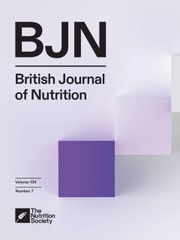Crossref Citations
This article has been cited by the following publications. This list is generated based on data provided by
Crossref.
Hopwood, Deborah E.
Pethick, David W.
Pluske, John R.
and
Hampson, David J.
2004.
Addition of pearl barley to a rice-based diet for newly weaned piglets increases the viscosity of the intestinal contents, reduces starch digestibility and exacerbates post-weaning colibacillosis.
British Journal of Nutrition,
Vol. 92,
Issue. 3,
p.
419.
Lichtenstein, Alice H.
Appel, Lawrence J.
Brands, Michael
Carnethon, Mercedes
Daniels, Stephen
Franch, Harold A.
Franklin, Barry
Kris-Etherton, Penny
Harris, William S.
Howard, Barbara
Karanja, Njeri
Lefevre, Michael
Rudel, Lawrence
Sacks, Frank
Van Horn, Linda
Winston, Mary
and
Wylie-Rosett, Judith
2006.
Diet and Lifestyle Recommendations Revision 2006.
Circulation,
Vol. 114,
Issue. 1,
p.
82.
Warren, Jeremy
Bhalla, Varun
and
Cresci, Gail
2011.
Postoperative Diet Advancement: Surgical Dogma vs Evidence‐Based Medicine.
Nutrition in Clinical Practice,
Vol. 26,
Issue. 2,
p.
115.
Alvarez-Ordóez, Avelino
Martínez-Lobo, Francisco
Arguello, Héctor
Carvajal, Ana
and
Rubio, Pedro
2013.
Swine Dysentery: Aetiology, Pathogenicity, Determinants of Transmission and the Fight against the Disease.
International Journal of Environmental Research and Public Health,
Vol. 10,
Issue. 5,
p.
1927.
Medhanie, Genet A.
McEwen, Scott A.
Weber, Lloyd
Sanei, Babak
Cooley, Leanne
Houghton, Scott
Slavic, Durda
and
Guerin, Michele T.
2013.
Risk factors associated with the colonization of Ontario layer chicken flocks with Brachyspira species.
Preventive Veterinary Medicine,
Vol. 109,
Issue. 3-4,
p.
304.
S., Padma Ishwarya
and
P., Prabhasankar
2014.
Prebiotics: Application in Bakery and Pasta Products.
Critical Reviews in Food Science and Nutrition,
Vol. 54,
Issue. 4,
p.
511.
Hampson, David J.
La, Tom
and
Phillips, Nyree D.
2015.
Emergence of Brachyspira species and strains: reinforcing the need for surveillance.
Porcine Health Management,
Vol. 1,
Issue. 1,
Grahofer, Alexander
Overesch, Gudrun
Nathues, Heiko
and
Zeeh, Friederike
2016.
Effect of soy on faecal dry matter content and excretion of Brachyspira hyodysenteriae in pigs.
Veterinary Record Open,
Vol. 3,
Issue. 1,
Rojas, Oscar Javier
and
Stein, Hans Henrik
2017.
Processing of ingredients and diets and effects on nutritional value for pigs.
Journal of Animal Science and Biotechnology,
Vol. 8,
Issue. 1,
Wang, L.F.
Zhang, H.
Beltranena, E.
and
Zijlstra, R.T.
2018.
Diet nutrient and energy digestibility and growth performance of weaned pigs fed hulled or hull-less barley differing in fermentable starch and fibre to replace wheat grain.
Animal Feed Science and Technology,
Vol. 242,
Issue. ,
p.
59.
Schweer, Wesley P
Burrough, Eric R
Patience, John F
Kerr, Brian J
and
Gabler, Nicholas K
2019.
Impact ofBrachyspira hyodysenteriaeon intestinal amino acid digestibility and endogenous amino acid losses in pigs1.
Journal of Animal Science,
Vol. 97,
Issue. 1,
p.
257.
Park, Sungkwon
Cho, Sungback
and
Hwang, Okhwa
2020.
Effects of Italian Ryegrass (IRG) Supplementation on Animal Performance, Gut Microbial Compositions and Odor Emission from Manure in Growing Pigs.
Agronomy,
Vol. 10,
Issue. 5,
p.
647.
Zeeh, Friederike
Vidondo, Beatriz
and
Nathues, Heiko
2020.
Risk factors for the infection with Brachyspira hyodysenteriae in pig herds.
Preventive Veterinary Medicine,
Vol. 174,
Issue. ,
p.
104819.
Lee, Geon Il
Skou Hedemann, Mette
Borg Jensen, Bent
and
Bach Knudsen, Knud Erik
2022.
Influence of infection with Brachyspira hyodysenteriae on clinical expression, growth performance, and digestibility in growing pigs fed diets varying in type and level of fiber.
Journal of Animal Science,
Vol. 100,
Issue. 5,
Holenweger, Fabienne
Schüpbach, Gertraud
Hofer, Andreas
Sidler, Xaver
and
Grahofer, Alexander
2023.
Housing and management factors and breed predisposition for haemorrhagic bowel syndrome in swine.
Porcine Health Management,
Vol. 9,
Issue. 1,
Yang, Xugang
Wen, Dongxu
Liu, Zhenjiang
Zhang, Ying
Danzengjicha
Yixiduoji
Huang, Xiaodan
and
Li, Bin
2024.
Biofermentation of aquatic plants: Potential novel feed ingredients for dairy cattle production.
Science of The Total Environment,
Vol. 952,
Issue. ,
p.
175955.


